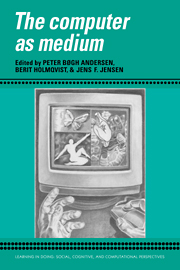Book contents
- Frontmatter
- Contents
- Series foreword
- Preface
- Contributors
- Part I Computer-based signs
- Part II The rhetoric of interactive media
- Introduction
- 6 Narrative computer systems: The dialectics of emotion and formalism
- 7 Interactive fiction: Artificial intelligence as a mode of sign production
- 8 Plays, theaters, and the art of acting in the eighteenth century: A formal analysis
- 9 The meaning of plot and narrative
- 10 Face to interface
- 11 Drawing and programming
- 12 Hypermedia communication and academic discourse: Some speculations on a future genre
- Part III Computers in context
- Index
Introduction
Published online by Cambridge University Press: 05 October 2010
- Frontmatter
- Contents
- Series foreword
- Preface
- Contributors
- Part I Computer-based signs
- Part II The rhetoric of interactive media
- Introduction
- 6 Narrative computer systems: The dialectics of emotion and formalism
- 7 Interactive fiction: Artificial intelligence as a mode of sign production
- 8 Plays, theaters, and the art of acting in the eighteenth century: A formal analysis
- 9 The meaning of plot and narrative
- 10 Face to interface
- 11 Drawing and programming
- 12 Hypermedia communication and academic discourse: Some speculations on a future genre
- Part III Computers in context
- Index
Summary
During the last twenty years, computer technology has undergone an explosive development. From being a professional challenge to engineers, the computer has developed into a medium among other media in information society – in fact, a super medium that incorporates many other media. Gunnar Liestøl's chapter discusses this fact in the context of academic interactive publishing, and there are many other fields of application. We use email instead of traditional paper-based mail, we enter virtual classrooms instead of taking the train to participate in a weekend course, and our children play computer games together with their friends instead of reading books about cowboys and Indians. Very soon we will exchange the videotape and video recorder for a CD-ROM player connected to our combined television/computer, so that we do not have to passively watch old films but can actively engage in the film making ourselves. But “Powerful media technology is meaningless without content.” Unfortunately “In the area of interactive motion video, the embryonic technology is already outrunning creativity” (Larry Press in Communication of the ACM. Vol. 32, no 7. 1989: 788).
Expressions like “interactive fiction,” “multimedia,” and “virtual reality” are becoming familiar. With the new technology we can create simulations of possible and impossible worlds for people to enter and act in, being absorbed and fascinated by. But what kind of worlds? Soldiers can learn how to land an airplane or destroy a tank electronically.
- Type
- Chapter
- Information
- The Computer as Medium , pp. 143 - 147Publisher: Cambridge University PressPrint publication year: 1994



